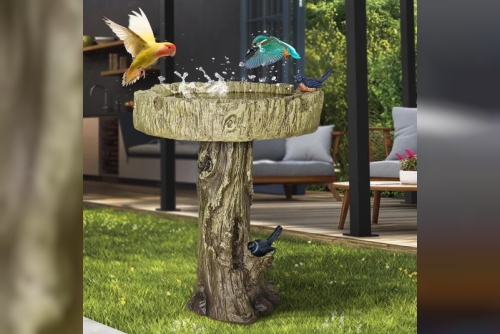When choosing the best bird baths for your garden or backyard, maintenance and cleanliness are critical factors to consider. A bird bath not only adds beauty to your outdoor space but also serves as a vital resource for local birds, providing them with water for drinking and bathing. However, to ensure that it remains functional and beneficial for your feathered friends, it’s essential to select a bird bath that is easy to maintain and clean. Here’s a guide to what makes the best bird baths in terms of upkeep and hygiene.
Material MattersThe material of the bird bath plays a significant role in how easy it is to clean and maintain. Common materials include:
Concrete: Known for its durability and weight, concrete bird baths are sturdy but can be challenging to clean due to their porous surface. They might require a bit more effort to scrub thoroughly. Plastic: Lightweight and affordable, plastic bird baths are often easy to clean with just soap and water. However, they may not be as durable as other materials and might degrade over time when exposed to the elements. Metal: Metals like copper or bronze are stylish and resistant to algae growth. They typically have smooth surfaces that are easy to clean, but they can be prone to rust if not treated properly. Ceramic: Ceramic bird baths can be attractive and easy to clean, especially if they have a smooth glaze. However, they can be fragile and may crack or chip.When selecting the best bird bath, opt for materials that combine durability with ease of cleaning. Smooth surfaces are preferable as they are less likely to harbor algae and other debris.
Design FeaturesThe design of the bird bath significantly affects its maintenance. Look for the following features in the best bird baths:
Removable Basins: Bird baths with removable basins allow for easy cleaning. You can lift out the basin, clean it thoroughly, and then replace it. This feature is particularly useful for routine maintenance. Shallow Depth: Shallow bird baths are easier to clean and prevent algae buildup. Birds prefer shallow water for bathing, which also makes it simpler for you to maintain the bath. Draining System: Effective drainage is crucial to prevent stagnant water, which can attract mosquitoes and other pests. Ensure the bird bath has adequate drainage holes to allow water to flow out. Smooth Edges: Bird baths with smooth, rounded edges are easier to clean. Sharp or ornate edges can trap debris and make the cleaning process more cumbersome. Easy Access for CleaningAccess to the bird bath for cleaning is another important factor. Here’s what to look for:
Wide Openings: Bird baths with wide openings allow you to easily reach inside for scrubbing and cleaning. A larger basin is often easier to clean than a smaller, more confined one. Lift-Out Features: As mentioned earlier, bird baths with lift-out features can simplify the cleaning process. Some models have detachable components that make it easier to clean different parts of the bird bath. Low Maintenance Materials: Some bird baths are coated with anti-algae treatments or have self-cleaning properties. While these features can reduce maintenance, regular cleaning is still necessary to keep the bath in optimal condition. Placement and LocationWhere you place the bird bath also affects how often it needs cleaning. Consider the following tips:
Avoid Overhanging Trees: Placing the bird bath under a tree or in an area with heavy leaf fall can lead to more frequent cleaning. Debris from trees can quickly dirty the water and make the bath harder to maintain. Sunlight Exposure: While some sunlight is beneficial, too much direct sunlight can encourage algae growth. Position the bird bath where it receives partial shade to minimize algae buildup. Easy Accessibility: Place the bird bath in a location that is easy for you to access for regular maintenance. Ensure you have enough space around it to maneuver while cleaning. Cleaning RoutineMaintaining a regular cleaning routine is essential for the longevity and effectiveness of your bird bath. Here’s a simple guide:
Weekly Cleaning: At least once a week, empty the bird bath, scrub the basin with a non-toxic cleaner, and rinse thoroughly. This prevents algae growth and keeps the water fresh. Seasonal Maintenance: During the colder months, ensure that the bird bath does not freeze over. Some bird baths come with heaters to prevent freezing. Inspect Regularly: Regularly check for cracks, damage, or signs of algae and mold. Promptly address any issues to prevent further problems.By choosing a bird bath with the right material, design features, and placement, and by adhering to a consistent cleaning routine, you can ensure that it remains an attractive and functional addition to your garden. The best bird baths not only enhance your outdoor space but also provide a clean and safe environment for your avian visitors.
















